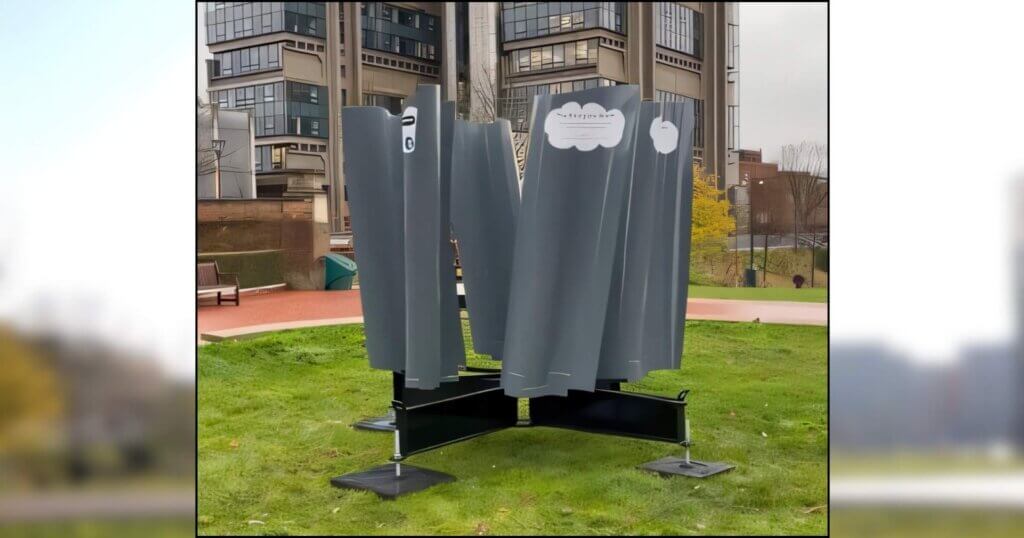Cities are under growing pressure to produce clean energy in tighter spaces, and traditional wind turbines just don’t fit the bill. That’s where the Birmingham Blade comes in. Designed with the help of artificial intelligence, this sleek urban turbine is compact and quiet, changing the way we think about renewable power in the heart of our cities.
Quick look:
- The Birmingham Blade, developed with AI by EvoPhase and Kwik Fab, is the world’s first wind turbine tailored for a specific city, offering clean power even in Birmingham’s low-speed wind conditions.
- Inspired by humpback whale fins, the Blade’s curved design improves performance in turbulent urban wind, blending nature’s ingenuity with next-gen tech.
- Unlike traditional turbines, the Birmingham Blade is optimized for rooftops and dense spaces; up to 7x more efficient in low-wind urban environments.
- Beyond wind, AI is revolutionizing energy systems, from solar optimization and smart grids to adaptive HVAC and battery storage.
Why this urban wind turbine is different
Developed by UK-based AI firm EvoPhase in collaboration with Kwik Fab, the Birmingham Blade is the world’s first urban wind turbine designed entirely by artificial intelligence and tailored to a specific geographic area.

Scientists at EvoPhase knew a traditional wind turbine wouldn’t cut it in a dense urban environment like Birmingham. “We needed a turbine that could capture Birmingham’s relatively low wind speeds while managing turbulence caused by surrounding buildings,” said Leonard Nicusan, chief technology officer of EvoPhase, in a press release.
Instead of relying on outdated design frameworks, the team turned to AI to explore new aerodynamic possibilities. “Using AI was essential for breaking free from the long-standing biases that have influenced wind turbine designs for the past century,” said Nicusan.
Through this approach, EvoPhase found that a curved blade design spinning around a central point delivered the best results, offering up to seven times greater efficiency than current models in similar Birmingham conditions.
“AI allowed us to explore design possibilities beyond the scope of traditional human experimentation,” Nicusan added. “We were able to generate, test, and refine over 2,000 urban wind turbine designs in just a few weeks, significantly accelerating our development process and achieving what would have taken years and millions of pounds through conventional methods.”
Inspired by nature, built for the city
The Blade’s design takes cues from nature, a concept known as biomimicry. Its curved blades are inspired by the tubercles (bumps) on humpback whale fins, which help reduce drag and improve lift. This natural blueprint allows the turbine to perform efficiently even in the turbulent, low-speed winds found between buildings.
Real-world results
The Birmingham Blade delivers impressive performance:
- Up to 7x more efficient than traditional turbines in Birmingham’s wind conditions
- Compact and quiet, making it ideal for rooftops and dense urban areas
- Visually unobtrusive, blending into the cityscape without towering over it
With AI-driven designs, the possibilities are endless
The Birmingham Blade is just the beginning of AI driven design. Artificial intelligence is transforming how we design, build, and optimize renewable energy systems across the board.
Smarter wind, smarter layouts
In the wind industry, AI is revolutionizing turbine design and wind farm layouts. By analyzing vast datasets, AI can identify optimal turbine placements and configurations, leading to increased energy output and reduced costs. For instance, AI-driven predictive maintenance can identify potential failures before they occur, minimizing downtime and reducing repair costs.
AI in solar, hydro, and HVAC
In solar power, AI is used to optimize panel orientation and tilt angles, maximizing energy capture throughout the day. In hydropower, AI improves turbine performance by analyzing operational data to increase efficiency and reduce environmental impacts. For building climate control, AI-powered HVAC systems adjust settings in real-time based on occupancy and weather patterns, leading to significant energy savings and improved comfort.
Will we see more AI-driven designs in the future?
As global climate goals become more ambitious and urban energy demands surge, AI-assisted design is swiftly transitioning from a novel concept to a cornerstone of sustainable innovation. The success of the Birmingham Blade shows how AI can revolutionize renewable energy solutions, paving the way for broader applications across various sectors.
Emerging applications of AI-assisted design
- Real-time solar tracking: AI-powered solar tracking systems, like those developed by SunPower, adjust panel positions based on real-time data, optimizing energy capture even under fluctuating weather conditions.
- Optimized battery storage systems: Tesla’s Autobidder platform uses AI to autonomously manage and monetize battery assets, enabling efficient energy storage and distribution.
- Adaptive smart grids: AI enhances smart grid capabilities by predicting energy demand, managing load distribution, and integrating renewable sources, resulting in more resilient and efficient energy networks.
- Hydropower efficiency: Companies like HYDROGRID employ AI to optimize hydropower operations, adjusting turbine performance in real-time to maximize output while minimizing environmental impact.
- Energy-efficient building materials: AI aids in the development of advanced building materials, such as AI-enhanced aerogels, which improve insulation and reduce energy consumption in modern constructions.
Final thoughts
The Birmingham Blade shows us what’s possible when we let artificial intelligence do more than crunch numbers. By combining smart design with real-world application, it’s proving that clean energy can be sustainable, elegant, and built for the urban spaces we live in.
From smarter power grids to climate-adaptive architecture, we’re just beginning to scratch the surface of how intelligent systems can solve the world’s toughest energy challenges.
Want more stories like this? Subscribe to our newsletter for the latest in sustainable tech, AI innovation, and the future of energy.


